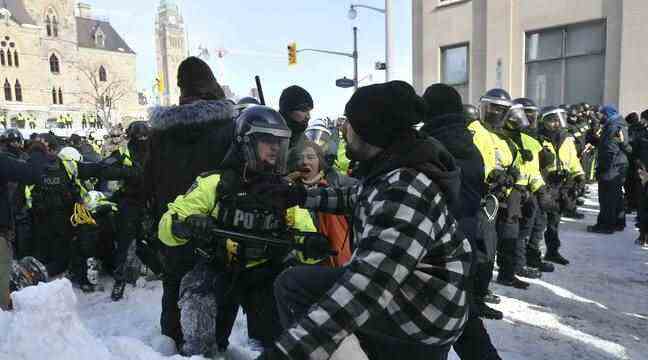Ottawa police officers regained control of a major axis in front of the Canadian Parliament this Saturday, using “irritating substances” to dislodge the hundreds of truckers who are still paralyzing central Ottawa, protesting for more than three weeks of protest. against sanitary measures.
“The protesters continue to be aggressive and to attack the officers”, have tweeted the authorities of this usually very calm city where the tension rose a notch after clashes in the night on Friday night. “They refuse to obey orders to move,” they say, adding that they used “chemical substances” against them.
Faced with these recalcitrant protesters, some of whom threw smoke bombs at the police and formed a human chain, the authorities said they used “irritating substances”. They regained control of the main street in front of Parliament at midday on Saturday, arresting 47 people, some of whom were carrying fireworks.
Last resistance?
Moments before a new police assault, the demonstrators still on the spot were cleaning their snow-covered signs, denouncing the sanitary measures linked to Covid-19. Others tried to warm themselves near a campfire under the frantic horns of the trucks still present.
“I’m not leaving,” says Johnny Rowe, brushing aside the risk of arrest. “There is no turning back,” he said. “Everyone here, myself included, has had their lives destroyed by what has happened over the past two years.”
“Anyone found in the area” of the center of the Canadian capital “will be arrested” warned the police on Twitter this Saturday, accusing the truckers, many of whom came with children, of putting them in danger.
Renewed tension and aggressiveness
Earlier in the morning the authorities had already pointed out that they had equipped themselves with “helmets and batons” in the face of the increased aggressiveness of the demonstrators.
Many truckers, however, chose to leave on their own and take their truck off the streets. “I’m leaving today,” says Vince Green, who explains that he has to return to Calgary, Alberta to take care of his children. His nursing wife lost her job, he says, because of her refusal to get vaccinated.
Minimized at the start by the authorities, this movement called “Convoy of freedom”, initiated at the end of January, started from truckers protesting against the obligation to be vaccinated to cross the border between Canada and the United States. But the demands have extended to a refusal of all health measures and, for many demonstrators, to a rejection of the government of Justin Trudeau.
emergency meeting
After an exceptional day of closure due to the security context, Parliament resumed its work this Saturday around the use of the law on emergency measures decreed by the Canadian Prime Minister, who also convened a crisis meeting on Saturday. .
The chamber has been examining since Thursday the implementation of this law invoked on Monday by Justin Trudeau to put an end to the “illegal” blockages in progress in the country. This is only the second time this provision has been used in peacetime, and it is highly contested by the Conservative opposition.
Justin Trudeau assured that the law would not be used to send the army against protesters or limit freedom of expression. The goal is simply “to face the current threat and fully control the situation”, he said at the end of the week.

